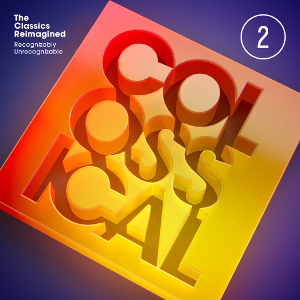The Classics Remixed: Making “Colossical” — A High Concept Music Library
In the film “Bill & Ted’s Excellent Adventure”, there is a truly magical scene: Beethoven, time-traveled forward 200 years or so, gets the chance to jam out on a battery of modern-day synths. Just as he’s really heating up, however, a squad of mall cops shuts him down — leaving the audience to wonder what musical breakthroughs might have been.
For all who experienced musicus interruptus when that 1989 gem originally screened, relief may finally have arrived in the form of “Colossical.” Created by NYC-based production music specialists VideoHelper, it’s a concept-driven library of classical music formatted specifically for ads, promos and movie trailers – imagine the masterpieces lodged permanently in your brain being bashed in an atom smasher, and you’ve got the picture.
For VideoHelper founders Joseph Saba and Stewart Winter, the impetus for “Colossical” lay in a simultaneous reverence for the greatest classical music works of the Western world, and frustration with the relatively limited uses that these pieces – positively bristling with archetypal artillery – had available to them in today’s music-for-picture universe.
“We found people were going through recordings of Beethoven’s Ninth Symphony and using the same 90 seconds of it,” explains Winter. “So we decided, ‘Why don’t we take that part and condense it further so it tells a story?’ But then let’s also build on the recognizable melody, and give it a trailer-music style, larger-than-life feel to it.”

The Classics: Two Ways
As the plan began to take shape, the trick was to not only reinterpret the aural wonders penned centuries ago by the hands of Mozart, Wagner, and Chopin, but also make them consistent with the easy-to-edit qualities of all of VideoHelper’s other libraries: each cut had to offer loopable sections, modular hit points, multiple climaxes, and paste-ready endings to facilitate fast customization at the hands of a time-starved video or audio editor.
Wielding a “Bigger Better Shorter” mandate, the result is two two-disc volumes for the newly launched “Colossical.” One is “Orchestral Intensifications,” which presents each piece as a cinematic, over-the-top, larger-than-life, hyper-dynamic orchestral movie trailer, and features performances from members of the Czech Republic’s Capellan Orchestra. Each track also offers multiple melodic variations, as well as variations in mood and tonality, thereby increasing the storytelling options.
The other is “Hybridized Reimaginings,” which remixes the orchestral versions and reinterprets them. VideoHelper’s elite team of composers were encouraged to go in every conceivable direction remixing the Orchestral Intensifications recordings. That led to classical/modern Frankensteins like a horror-movie version of Ponchielli’s “Dance of the Hours,” and a -70’s Blaxploitation-themed Chopin’s “Funeral March.” All versions of each piece share the same key and tempo, allowing them to be used interchangeably.
Cartoon Canon
With the concept mapped out, the next step was to narrow down which lucky selections would be targeted by VideoHelper for transmogrification. For assistance, Saba and Winter didn’t quiz a Columbia University archivist – they turned to a wascally wabbit.
“We call this ‘The Bugs Bunny Canon’, because all of these classical pieces had been used in Bugs Bunny cartoons,” explains Winter. “When we were going through the top 150 public domain pieces, it was amazing how many of them were used by Bugs Bunny. But that’s a big reason why many of us remember them from childhood.”
The list of winners are guaranteed to light up memory banks, including Beethoven’s Symphony No. 5, Tchaikovsky’s 1812 Overture, Rossini’s Barber of Seville and William Tell Overture, Mussorgsky’s Night on Bald Mountain, Wagner’s Ride of the Valkyrie, Strauss’ Blue Danube, and Mozart’s 40th Symphony.
Constructing the Reconstructions
From there, the challenge was matching up these iconic works with the right composer to create the new arrangements. VideoHelper’s five in-house composers are always occupied with cuts for ongoing projects like their “Modules” library (see how they’re networked together in this previous article on SonicScoop), so Saba and Winter auditioned several outside candidates before deciding on LA-based Aaron Sapp.
“He’s a phenomenally good composer,” Winter says of Sapp, “and he also understands what it takes to build emotion, and how to basically fake people out: It’s not just about getting louder and louder – sometimes you lead them to the cliff, and let them dangle there for a second.
“Aaron saw what we were looking for was not just the ability to boil ‘Ride of the Valkyries’ down to thirty seconds, but to add a twist. It’ll sound like Wagner, so you can still identify it and it’s convenient for telling a story. But instead of only dark and brooding, it later becomes joyful and proud.”
A busy film and TV composer whose credits include ABC, NBC, CBS, FOX, WB, the History Channel, TBS, Cartoon Network, and multiple game titles, Sapp took on the project with a surprisingly minimalist rig in his Woodland Hills, CA studio.
“My setup is really basic,” says Sapp. “No outboard and three computers – one DAW running Cubase 5, and two Gigastudio machines. I also have two speakers, a Kurzweil PC88, and a 15-year old mixer. Only what I need.”
Sapp, Saba and Winter kicked off their cross-country collaboration with “the most recognizable piece ever” in Beethoven’s Fifth Symphony. After discussing the emotional payoffs that VideoHelper was going for, Sapp would sketch out each piece in Cubase, using his MIDI keyboard to map out a preliminary woodwind, strings and brass arrangement.
“The most difficult part was to do each selection within the VideoHelper format, where they have to end at 29 seconds,” Sapp notes. “That’s tricky with some of those classical pieces, because sometimes the melody is longer than 29 seconds! I would try to come up with a build within those 29 seconds that sounds coherent, and doesn’t sound contrived.
“If the piece was in a major key, I’d make a minor key iteration of it, a slow or a fast version, a really small dainty version, a bombastically huge version and just about anything in between. For the most part, they let me run with it, and compose something that was appropriate while using these themes and motifs, all while still trying to retain the spirit of the original piece.”
Once Sapp’s initial arrangements were approved, he would write and record full arrangements within his DAW, using custom orchestral samples formatted to run on Gigastudio. VideoHelper upped the ante from there by recording many of the brass parts with the Czech Republic’s Capellan Orchestra via a SourceLive networked session.
Making Mozart Fit to Picture
Looking to the classics for inspiration is always laudable, but VideoHelper isn’t copping Chopin to be on the safe side. For Saba and Winter, providing a practical solution to content producers was the primary objective.
“There are a lot of trailer libraries that are large for large sake, and also so many classical libraries that just all sound the same,” says Winter. “We wanted to improve on both. To do something that was over the top – with an abnormal amount of bombast: drums ten layers deep, or an unnatural number of horns. We take it to the ridiculous, go-nuclear level. But still always making sure the music tells a story.”
VideoHelper’s trademark method of ensuring that each track has plentiful, and precisely timed, hits and stings kept the classical reworks constantly challenging for Sapp. “Some of the variations would be a really quiet version, very slow, massive, or comedic – basically anything I felt was useful,” he explains. “I had to approach this from an editor’s standpoint and say, ‘What would be useful to me if I were an editor?’
“When you’re talking about the classics, the orchestrations are masterful, but there’s a lot of details that would get lost in television. So I would more or less distill the orchestrations, so that the meat and potatoes would be much more well-represented and punchy.”
Sapp points to Mendelssohn’s “Wedding March” as a good example of a Colossical-style makeover. “I did a :30 minor key variation that they liked so much they asked me to make a whole, 2:00 dark version of the Wedding March,” Sapp explains. “They said, ‘Make it the most horrible wedding you’ve ever been to.’ I came up with a few ideas, and the last one I did is the aural equivalent of the Spanish Inquisition. It’s horrific. That one was a lot of fun.”
Getting Saba’s and Winter’s stamp of approval on a track is notoriously difficult – a fact that ramped up both the stress and satisfaction levels for Sapp. “They are very anal retentive about quality,” Sapp says frankly. “The commitment required of their in-house composers is about a track a week, which need to be a minute long. Any composer reading that would say, ‘That’s nothing!’ But then you see everything they ask for, and you can understand why it takes upwards of a week to come up with one minute. It can be very trying, but because of them I’ve improved as a producer far more quickly than I would have on my own.”
Where VideoHelper really surprised themselves was with the remix phase of the project, Hybridized Reimaginings. “The remixes have really been wildly creative – we didn’t expect them to be as good as they are,” Winter notes. “There are mariachi versions, Tarantino-esque Tex-Mex stuff, and heavy metal. But it’s all musical, and not just some throw-off jokes.”
“When I finally got the chance to listen to the remixes, I almost fell out of my chair laughing,” Sapp adds. “It was odd to work on these themes for so long, and then hear how VideoHelper’s in-house guys destroyed them in the best possible way.”
Staying Power
Maybe somewhere Ponchielli is turning over in his grave over VideoHelper’s EDM remake of “Dance of the Hours”. But hopefully he’ll rest a little more in peace knowing that the synch license for his altered masterpiece, now playing against network coverage of a Des Moines pie-eat in double time, was obtained with the utmost respect.
As people’s time spent with the classics grows deeper by the day, so does our understanding of the underlying musical mastery required to compose them in the first place. For everyone involved, the Colossical project reinforced why a construct like the Light Calvary Overture remains a hit for centuries.
“The one thing I can really appreciate from listening to these arrangements,” says Aaron Sapp, “is how they’re able to take a simple idea and make all kinds of variations on it, in really compelling ways. That goes a long way today as well.”
Likewise, Stewart Winter gets uncharacteristically serious reflecting on what VideoHelper learned from producing Colossical – an unexpected benefit from the hundreds of hours of classical immersion. “The orchestrations are so well-written,” he says. “There’s such beauty in them, and complexities beneath the surface with phenomenal effects. It’s amazing to look at these pieces and see how well-organized they are. There’s not a wasted note.”
— David Weiss
Please note: When you buy products through links on this page, we may earn an affiliate commission.









say what?
July 19, 2013 at 4:19 am (12 years ago)total crap